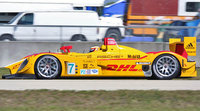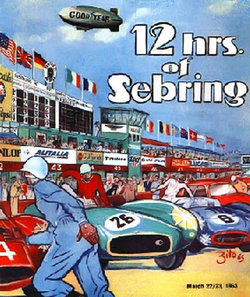Difference between revisions of "12 Hours of Sebring"
m |
m |
||
| Line 28: | Line 28: | ||
=== Overall Winners=== | === Overall Winners=== | ||
| − | {| | + | {| border=1 cellspacing=3 cellpadding=4 style="float:center; margin:0 0 .5em 1em; width:800px; background:#505050; border-collapse:collapse; border:1px solid #999; font-size:83%; line-height:1.5; " summary="Infobox Automobile" |
| − | |- tr BGCOLOR= | + | |- style="text-align:center; background:#505050;" |
| + | |- tr BGCOLOR=darkred | ||
! Year | ! Year | ||
! Drivers | ! Drivers | ||
Revision as of 21:29, 10 March 2009
The 12 Hours of Sebring is an annual motorsport endurance race held at Sebring International Raceway, a former Army Air Force base in Sebring, Florida.
History
The track opened in 1950 on an airfield and is a road racing course styled after those used in European Grand Prix motor racing. The race is now considered one of the premier endurance races in the United States and is famous for its "once around the clock" action, starting during the day and finishing at night. For many years Sebring was part of the World Sportscar Championship.
The race has a rich history, as legendary drivers such as Mario Andretti, Briggs Cunningham, Juan Manuel Fangio, A.J. Foyt, Jacky Ickx, Stirling Moss and Lake Underwood, and manufacturers such as Ferrari, Porsche, BMW, Jaguar, Cunningham, Audi and Ford have all been victorious.
It is known as an excellent preparation for the famous 24 Hours of Le Mans, as the track's extremely bumpy surface, combined with south-central Florida's perennial hot weather, is a true test of a car's reliability. In recent years, six overall victories have been achieved by the Audi R8, one less than record seven wins of the Porsche 935.
The Event
Fans are allowed to camp inside the green of the race track, starting several days before the actual race. Both general admission and, for a fee, reserved camping exists. RVs and cars are allowed into the track. Fans that show up during the week (and in some cases months before the actual race) can bear witness to many practice and qualification races, as well as a vintage race. There are several classes of tickets, ranging anywhere from full-access to simply the (usually Saturday) actual race. The tickets are numbered, and there are designated numbered tickets needed to access pit areas, press and spectator boxes, and certain parts of the track.
Within the track is a Midway, containing everything from souvenirs and official merchandise, to hot coffee and cold beer. Attractions are also featured in the midway and differ from year to year; In recent years Spring Break attractions have been set up to draw in college students on break during the week of the race. Radio promotions for the race are not uncommon to hear in Florida weeks before the race, advertising to both race fans and spring breakers.
Recent results
In 2005, the Chevrolet Corvette C6.R and Aston Martin DBR9 made their race debut in the hotly contested GT1 class, with Aston Martin winning its class for the first time in 49 years at Sebring ahead of the two Corvettes. Corvette had dominated the class the past three years with its previous generation C5R.
The all-new Audi R10 TDI won the 2006 edition of the race, the car's first ever run in competition. The victory set the stage for an even more momentous win by the R10 in its next race, the Le Mans 24 Hours later in the year. The much-hyped Porsche RS Spyder campaigned by Penske Racing dropped to take 2nd place in its LMP2 class, behind the Intersport Lola car. The GT1 Corvette C6R team got their revenge against the Aston Martin, although the second Corvette came within 1/3 of a second of the podium in the closing laps of the race.
2007 saw Audi again winning in the R10 TDI despite requiring more frequent refueling due to changes in American Le Mans series rules intended to even the field between gasoline and diesel powered engines. In addition to an overall win, Audi also set a track record in 2007 with Marco Werner behind the wheel in qualifying.
Overall Winners
† - These races were stopped for a period of time due to heavy rain and/or accidents. The race clock was not stopped for these periods and counted towards the 12 Hours.
‡ - Race record for most distance covered


